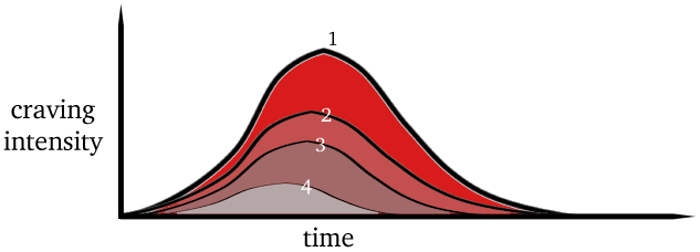Whenever smokers go without nicotine for more than a couple of hours this restless, hunger, shock, fright feeling begins to well up to the point that the feeling can only be arrested by lighting up and inhaling yet another cigarette.
The next cigarette delivers another dose of nicotine to the bloodstream that immediately begins to dissipate restarting the whole process over again.
This is the craving cycle. A perfect ecosystem chemically engineered to sustain ongoing nicotine administration.
Dealing with cravings is one of the toughest things that any ex-smoker will has to deal with on a day to day basis. Cravings are unpredictable and can occur at any time even many years after stopping smoking.
To successfully beat nicotine cravings you need to come up with a viable strategy.
You can’t just quit smoking without an absolute game plan plan for dealing with cravings or you will just set yourself up for failure.
Some people drink water, others, focus on a work task or “displacement activity” whatever your plan is you need to stick to it so you don’t fall back into the trap.
What we do know about nicotine addiction and cravings for most ex smokers is that TIME is the universal HEALER. This is where you truly learn to “work at stopping smoking” and where you discover your non smoker self.
Let’s unpack TIME

Psychologically as nicotine raving
The merry-go-round is over
One of the main weak areas that can directly affect the intensity of the cravings relates to an often irrational and emotional memory of the good times that the patient would have associated with nicotine, this is also known in drug addiction as a “euphoric response” resulting in ongoing cravings.
Rather conveniently these euphoric based nicotine cravings do not involve any memories of the negative aspects and consequences of smoking. If the patients euphoric response craving is not addressed immediately it will certainly grow and grow until it becomes too powerful to ignore and the patient may suffer a relapse.
The more time that a patient has during recovery experiencing a life of sobriety the greater the chances are for a recovery without any further issues with cravings. Listed below are a few basic ideas and strategies that are designed to help you cope with cravings.
Let Someone Know
If you let someone know how you are feeling and that you are currently experiencing potentially harmful cravings then you have a far greater chance of avoiding a relapse. When you let a friend or family member or even a sponsor know how you are feeling then you acknowledge what you are feeling and can then address it positively and effectively. There are many that say that just talking to someone about the craving is enough to help them avoid relapsing.
Find a Distraction
Having a good hobby that is complex and time consuming is a great way to distract yourself form feelings of craving, this could be anything from working on your car, visiting a museum, spring cleaning or even just going for a nice long walk. Be sure to be in a healthy environment that does not involve and potential alcohol or drug situations.
Find a Support Group
Finding an active support group in your area is also a great way to stay clean and craving free. There are plenty of helpful organizations like AA or NA that have weekly meetings in almost every area.
Think Back on the Bad Times
This is very important, as we have already discussed, cravings are often emotional and irrational and have quite a bit to do with remembering good times that are associated with drugs or alcohol. It is far more constructive for you in avoiding relapsing and cravings to rather think of the bad times, thinking of all the pain and misery that drug or alcohol abuse has caused you, your family and your friends.
Dealing with Emotional Issues
Dealing with emotional issues is a very important aspect of addiction recovery. There are many instances where drug abuse can be traced back to an emotional need, an emotional fulfilling. If you are experiencing a craving you need to be able to identify what emotion is actually causing the craving and then deal with that emotion specifically.
